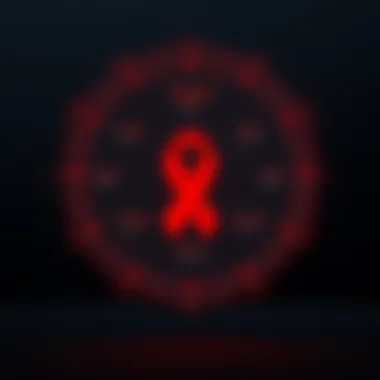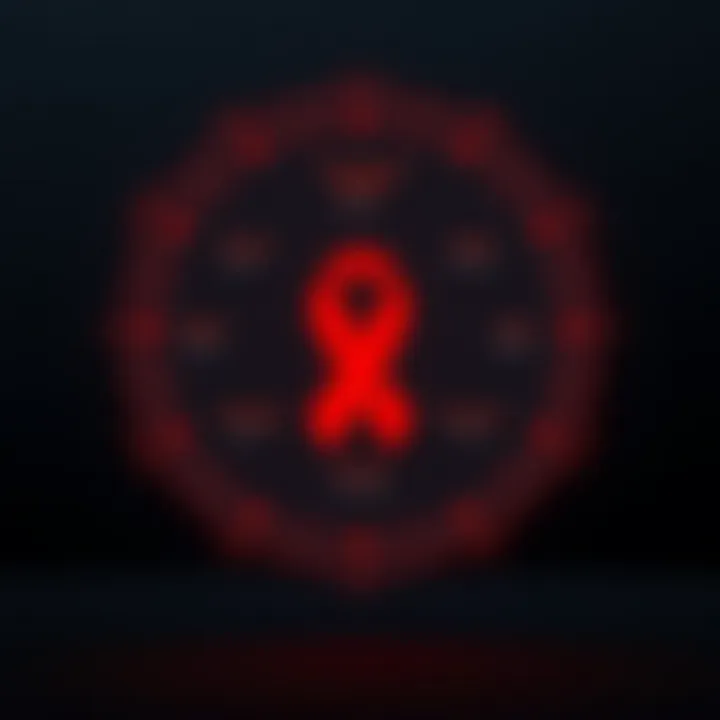HIV Survivability: Dimensions and Implications


Intro
HIV, a virus that has reshaped the medical landscape since its discovery, remains a pivotal point of research and discussion across various disciplines. Its implications stretch beyond the physiological realm, affecting individuals on psychological and social levels. Understanding survivability in the context of HIV encapsulates a range of factors, from advancements in medical treatments to the nuances of societal stigma that can hinder growth and acceptance.
As we embark on this exploration, it’s crucial to note that survivability does not simply denote longevity in the presence of the virus. Rather, it encompasses a holistic view of life quality, access to healthcare, and the emotional and mental resilience that individuals must cultivate. We aim to illuminate the interactions between science, society, and psychology, providing insights that foster informed discussions and enhanced awareness of those living with HIV.
By examining the evolving landscape of HIV treatment, psychological support, and societal perceptions, we hope to create a well-rounded understanding of this complex issue. This article endeavors to bridge the gaps in knowledge and stir conversations that are often sidelined in public discourse.
Prelims to HIV
HIV, short for Human Immunodeficiency Virus, is not just a medical condition; it's a societal phenomenon with far-reaching implications. The study of HIV encompasses areas ranging from its biological impact to the emotional and psychological toll it takes on individuals and communities. Understanding HIV is essential, as it informs strategies for prevention, treatment, and support, ultimately influencing the quality of life of those affected.
The relevance of addressing HIV in this article lies in its multifaceted nature. First and foremost, recognizing the virus's background and how it operates within the body provides a solid foundation for grasping the impact of current medical advancements. Furthermore, acknowledging the social and psychological aspects of living with HIV allows for a more rounded approach to healthcare, highlighting that medical treatment cannot act in isolation without considering mental well-being and social support.
While HIV remains a chronic condition, the narrative has shifted remarkably—thanks in part to antiretroviral therapy (ART) and heightened awareness. However, misconceptions and stigma surrounding HIV still endure. This article delves into various dimensions of HIV survivability, emphasizing not only life expectancy but also the quality of life in both physical and mental health realms. By breaking down complex layers and sensitive subjects, we aim to foster understanding and spark dialogue around these crucial issues.
Definition and Background
HIV is a virus that targets the immune system, specifically CD4 cells, which play a pivotal role in fighting infections. If untreated, HIV reduces the number of these cells, leading to a weakened immune response. It is important to note that while HIV can progress to Acquired Immunodeficiency Syndrome (AIDS), not everyone with HIV will develop AIDS. The distinction is vital; with proper treatment, many individuals can live long and healthy lives.
The virus itself was first identified in the early 1980s, linked to several cases of rare infections and cancers among groups of young men in the United States. Over the years, researchers have unraveled various strains of HIV, predominantly categorized as HIV-1 and HIV-2. Understanding the biological underpinnings of these strains is essential for crafting effective responses and treatments.
The Global Impact of HIV
The ramifications of HIV extend well beyond individual health; they resonate through communities and nations. Globally, millions are living with HIV, and the statistics can be staggering. For example, as of 2021, it was estimated that about 38 million people were infected with the virus, with the highest prevalence in sub-Saharan Africa. This illustrates not only an ongoing public health crisis but a complex interplay of socioeconomic factors that influence infection rates and access to healthcare.
- Economic toll: Countries grappling with high HIV rates often face burdened healthcare systems, which can impede access to essential services.
- Social implications: Stigma surrounding HIV greatly affects those living with the virus. It can lead to discrimination, impacting employment opportunities, relationships, and mental well-being.
- Education and awareness: Increased education about HIV and its transmission is crucial for prevention. Awareness campaigns help shift societal views, fostering empathy and understanding instead of fear and isolation.
"Knowledge is power, particularly when it comes to health matters. Empowering individuals with information about HIV can lead to healthier communities."
Addressing these implications is not merely an academic exercise; it's essential for guiding policy changes and improving the lives of those affected by HIV worldwide.
Physiology of HIV Infection
Understanding the physiology of HIV is pivotal, as it dives into the intricacies of how this virus operates within the body. Grasping these mechanisms not only enlightens health professionals and researchers but also aids individuals living with HIV in navigating their condition with greater awareness. This section uncovers the fundamental pathways by which HIV interacts with human cells, how it propagates within the system, and the resulting implications on health.
How HIV Works in the Body
HIV is a virus that primarily targets the immune system, specifically the CD4+ T cells, which are integral for a robust immune response. When HIV enters the body, it attaches itself to these cells, using the CD4 receptors as a gateway. Picture this like a lock and key setup—HIV acts like the key that opens the door to the immune cells.
Once inside, HIV injects its genetic material, RNA, into the host cell. The host cell, unaware of the infiltration, lets the virus hijack its machinery to produce more copies of itself. This replication process is called the lytic cycle, leading to the cell's eventual destruction.
The process unfolds in several steps:
- Attachment: HIV binding to the CD4 receptor and co-receptors on the T cells.
- Entry: Fusion and entry into the host cell.
- Reverse Transcription: HIV RNA is converted into DNA within the host cells.
- Integration: The viral DNA becomes part of the host cell's DNA.
- Replication: New viruses are produced using the host cell's resources.
Ultimately, this unregulated replication leads to a decrease in the number of CD4+ T cells, progressively weakening the immune system. This illustrates how HIV spreads not just through individual cells but also undermines overall health—allowing opportunistic infections to take hold.
Stages of HIV Infection
HIV infection manifests in distinct stages, each with its own characteristics and health implications. Recognizing these stages is essential for appropriate management and treatment. Below are the stages commonly identified in HIV progression:
- Acute HIV Infection: This stage occurs just weeks after exposure. Symptoms are often flu-like, including fever, fatigue, and swollen lymph nodes. It’s a crucial period to diagnose HIV, as the viral load is exceptionally high, making transmission more likely.
- Clinical Latency (Chronic HIV Infection): This phase can last for several years, often providing no symptoms. HIV remains active but reproduces at low levels. Individuals may not feel sick, but the virus is still capable of infecting others.
- AIDS (Acquired Immunodeficiency Syndrome): The final stage, marked by a severely weakened immune system. An individual may experience significant weight loss, prolonged fever, and other serious opportunistic infections. Without treatment, this stage leads to a high mortality risk.
The journey through these stages highlights the importance of early detection and management. Understanding this progression can empower those living with HIV to work closely with healthcare providers to devise optimal treatment strategies.
"Understanding the physiology and stages of HIV infection is essential not only for medical professionals but also for individuals and communities affected by the virus. Knowledge leads to informed decisions and more effective prevention strategies."
For more detailed insights on HIV, resources such as the CDC and World Health Organization can provide valuable information.


Treatment Options for HIV
Understanding the treatment options available for HIV is crucial. Effective management of the virus not only promotes better health but can lead to a life expectancy that mirrors that of the general population. The advancements in treatment have significantly reshaped the landscape of HIV care, enabling individuals to lead full lives despite the diagnosis.
Antiretroviral Therapy (ART)
Antiretroviral Therapy, commonly referred to as ART, is the cornerstone of HIV treatment. This medication regime works by reducing the viral load in the body to undetectable levels, which in turn helps protect the immune system. Here are some key considerations about ART:
- Mechanism of Action: ART includes a combination of medications that inhibit the virus’s ability to replicate. It blocks different stages of the viral lifecycle. This is vital because it prevents the virus from damaging immune cells, thereby enhancing the body's ability to fight off infections.
- Adherence is Key: Consistent use of ART is essential for its success. Missing doses can lead to drug resistance, complicating treatment. Some patients find it challenging to adhere due to side effects or complex regimens, which can hinder treatment efficacy.
- Monitoring: Regular follow-ups with healthcare providers are critical. They help track viral load and facilitate timely adjustments to therapy if necessary. Keeping one's doctor in the loop can help in managing any complications that arise during treatment.
- Benefits Beyond Health: Beyond controlling the virus, ART also has social benefits. By lowering viral loads, it drastically reduces the risk of transmission to partners, promoting safer relationships and reducing stigma.
"Adhering to ART not only aids in personal health but also contributes to a more supportive community atmosphere."
Emerging Treatment Strategies
As science continues to advance, new treatment strategies are emerging that promise to improve outcomes for people living with HIV. These strategies focus on innovative approaches and aim to enhance the effectiveness and convenience of HIV care.
- Long-Acting Injectables: One of the most promising developments is the introduction of long-acting injectable treatments. Administered every few months, these injections may enhance adherence compared to daily pills. This approach can significantly simplify treatment for many individuals.
- Prevention of Resistance: Researchers are focusing on new medications designed to combat drug resistance. Innovations like broadly neutralizing antibodies could offer alternative pathways to control viral loads and prevent the virus from evading treatment.
- Gene Therapy: Though still in early stages, gene therapy presents a thrilling prospect. This strategy aims to modify patients' cells so they can resist HIV infections entirely. While more research is needed, the potential to eradicate HIV at a cellular level has intrigued scientists and patients alike.
- Personalized Medicine: Tailoring treatments based on an individual's genetic makeup is another area being explored. By understanding each patient's specific response to various medications, healthcare providers may optimize treatment plans for better outcomes.
As research continues to evolve, the landscape of HIV treatment appears promising, aiming for a holistic approach that includes physical health, mental well-being, and social support.
For more information on treatment options, refer to the following resources:
Survivability and Quality of Life
Understanding the connection between survivability and quality of life for individuals living with HIV is crucial. It encompasses the broader narrative of how life with HIV can be navigated, not just from a purely medical standpoint but also through the lens of personal experience and societal context.
Life Expectancy with HIV
One of the most significant strides in contemporary HIV treatment is the enhancement of life expectancy. Years ago, a diagnosis of HIV was often perceived as a death sentence. Now, thanks to advancements in antiretroviral therapy, statistics show that individuals living with HIV can expect to live nearly as long as their HIV-negative counterparts, given they adhere to their treatment regimens. The key here is early diagnosis and consistent treatment.
A 2019 report from the Centers for Disease Control and Prevention highlights the average life expectancy for someone who is HIV-positive and receiving treatment can exceed 70 years. Yet, this hinges on factors like healthcare access, lifestyle choices, and adherence to therapy.
Physical Health Considerations
Living with HIV entails a range of physical health considerations that go beyond the virus itself. It’s essential to manage not only HIV but also any comorbidities that may arise. For example, individuals are at increased risk for various infections or diseases such as cardiovascular issues and certain cancers. Regular check-ups and screenings become pivotal in catching these potential health issues early.
Moreover, lifestyle adjustments play a critical role in maintaining physical health. A balanced diet, regular exercise, and avoiding harmful substances can lead to better health outcomes. Those who integrate healthy habits often report not only physical improvements but also a boost in mental wellbeing, highlighting the interconnections between body and mind. Key points to consider include:
- Regular consultations with healthcare providers
- Adopting a nutritious diet rich in vitamins and antioxidants
- Incorporating physical activity into daily routines
Mental Health Aspects
Mental health stands as a cornerstone of quality of life for individuals living with HIV. The psychological burden of stigma, fear of discrimination, and the general anxiety associated with living with a chronic illness can weigh heavily on a person's mental health. Research indicates a higher prevalence of depression and anxiety disorders among those diagnosed with HIV, compared to the general population.
Engaging in supportive counseling and therapy can make a significant difference. For many, joining support groups offers not only a sense of community but also a space to share experiences and strategies for coping. Notably, mental and emotional support contributes to better adherence to medical treatment, which can further enhance physical health outcomes.
"Mental health is not a destination, but a process. It's about how you drive, not where you're going."
In summary, the interconnectedness of survivability and quality of life for those living with HIV is multi-faceted. Factors such as life expectancy, physical health considerations, and mental health challenges play a pivotal role in shaping their daily realities. By addressing these areas holistically, we can foster a more nuanced understanding and support structure for individuals navigating life with HIV.
For more insights into HIV management, the CDC offers resources ranging from health guidelines to support resources. Other platforms like HIV.gov provide relevant information concerning treatment options and health education.
The Role of Psychological Support
Living with HIV is not just a matter of addressing the physical aspects of the disease. The psychological dimensions play an equally important role in enhancing survivability and quality of life for infected individuals. Mental well-being is intertwined with physical health, and understanding this connection can lead to more effective management of the virus. Psychological support serves to alleviate the mental burden that often accompanies a chronic illness like HIV and fosters a sense of empowerment and resilience.
The benefits of psychological support are manifold. Here are a few key points:


- Emotional Resilience: Individuals with strong psychological support systems often display greater emotional stability. This resilience can help cope with the ups and downs of living with HIV.
- Enhanced Coping Strategies: Therapy offers tools to handle stress and anxiety, allowing people to better navigate their daily lives and challenges posed by the virus.
- Communication Skills Improvement: Counseling often involves training in effective communication, which can lead to stronger relationships with partners, family, and friends, fostering a supportive environment.
In summary, the role of psychological support cannot be overstated. It not only assists individuals in grappling with their emotional responses to HIV but also enhances their overall quality of life.
Counseling and Therapy
Counseling and therapy are pivotal in the psychological support structure for people living with HIV. This kind of support provides a safe space for individuals to express their feelings and concerns without judgment. Therapy can take various forms—individual therapy, group sessions, or even online counseling. One of the most profound advantages of therapy is the ability to confront and process emotions in a managed way.
- Individual Therapy: In a one-on-one setting, individuals can delve into personal issues that may be affecting their mental health, such as grief, fear of stigma, or anxiety about treatment adherence.
- Group Therapy: Sharing experiences with others who are facing similar challenges can foster a sense of community. In group settings, participants can talk about their struggles, successes, and coping mechanisms in an understanding environment.
- Teletherapy: With the rise of technology, counseling options have expanded. Many people prefer online sessions for convenience, privacy, and often greater comfort in discussing intimate issues.
It's particularly worth noting that therapy can also guide individuals in establishing life goals and future aspirations, which is essential in cultivating a sense of hope and purpose.
Support Groups and Community Resources
Support groups and community resources complement counseling and therapy, acting as pillars of the social support network for individuals living with HIV. These platforms create a sense of belonging, reducing isolation and loneliness that many may feel during their journey with the virus.
- Peer Support: These groups often include individuals who are living with HIV, which helps in sharing real-life experiences. Peer-driven models can make a big difference, as advice from someone who truly understands the journey can feel more authentic and relatable.
- Educational Workshops: Many organizations offer workshops that educate about HIV management, treatment updates, and emotional coping strategies. This not only equips individuals with knowledge but also reinforces their sense of agency in managing their health.
- Crisis Resources: Having access to hotlines and emergency mental health services is crucial in times of distress. It acts as a safety net for individuals who need immediate support.
"Mental health is just as important as physical health. In fact, they are intertwined. Fostering a community of support can change the game for someone living with HIV."
For further resources, individuals may refer to:
CDC HIV Support
HIV.gov Resources
The Well Project
Facebook Groups for HIV Support
Reddit HIV Community
Societal Perspectives and Stigma
Understanding societal perspectives and stigma surrounding HIV is crucial for comprehending the broader implications of survivability. Stigma can drastically affect the lives of individuals living with HIV, influencing how they access care and how society treats them overall. It shapes perceptions, which in turn affects the mental wellbeing of those impacted. Addressing these issues is not just about improving the lives of individuals; it's about reshaping societal views and integrating an understanding of HIV into public health strategies.
Historical Context of HIV Stigma
In the early days of the HIV epidemic, the landscape was marked by fear, misinformation, and societal neglect. Initially perceived as a disease primarily affecting marginalized groups, notably the LGBTQ+ community and people who inject drugs, this misconception fueled stigma. Many individuals believed that HIV was a moral failing rather than a public health issue.
As the crisis escalated, blame was placed on those who were infected, leading to discrimination in many forms—loss of jobs, rejection in families, and even violence. Activist groups like Act Up and the Queer Nation emerged to combat not only the health crisis but also the stigma that surrounded it. Events like the “Day Without Art” brought visibility to the issue, showing the profound implications of loss due to HIV/AIDS.
This historical backdrop is integral to understanding how stigma has evolved and the roots from which current attitudes spring. Understanding these roots can better inform efforts to combat stigma today.
Current Attitudes Towards HIV
Today, while general awareness about HIV has increased significantly, stigma persists in various forms. Many individuals still face bias in healthcare settings, workplaces, and social arenas. Misunderstandings about how HIV is transmitted contribute to ongoing fears, leading to avoidance behaviors that perpetuate isolation.
However, there is a growing movement aimed at reducing stigma, fueled by education and campaigns that focus on the realities of living with HIV. The phrase “undetectable equals untransmittable” (U=U) has become a rallying call, signifying that with proper treatment, those living with HIV can lead healthy lives without transmitting the virus to others.
Social media platforms serve as a double-edged sword; they can both perpetuate stigma as well as provide forums for support and information sharing. Community organizations work tirelessly to create safe spaces and promote insightful dialogues around HIV, shifting perspectives one conversation at a time.
Ultimately, addressing stigma not only improves the quality of life for individuals living with HIV, but it also contributes to the dismantling of systemic barriers to health care. This progress can lead us closer to a society where individuals can seek help without fear of judgment or discrimination.
“Stigma is a social determinant of health. Reducing stigma goes hand-in-hand with improving health outcomes.”
By unpacking the layers of historical and current societal attitudes, we pave the way toward a more inclusive and compassionate approach to HIV, resulting in better health and a brighter future for those affected. Links like CDC HIV Data or World Health Organization's HIV Information can provide further insights and credible information.
Advancements in HIV Research
Understanding the ongoing advancements in HIV research is crucial for comprehending how far we have come in tackling this global health issue. The pace of innovation in this field has been astounding, leading to significant improvements in treatment protocols and the overall management of the virus. Researchers are now shedding light on not just surviving with HIV, but thriving despite it.
Innovations in Treatment
Recent innovations in treatment have transformed the lives of many individuals living with HIV. The development of antiretroviral therapy (ART) has played a vital role in reducing the viral load to undetectable levels. In simpler terms, undetectable equals untransmittable (U=U) has become a powerful slogan, emphasizing that people with an undetectable viral load cannot transmit the virus to their sexual partners.
In addition to ART, researchers have introduced long-acting injectables, which allow for treatment every few months rather than daily pills. This shift not only improves adherence but also lessens the stigma associated with taking medication every day.
Some recent key innovations include:


- Cabotegravir and Rilpivirine: These two medications have been used in injectable forms to provide patients with a convenient method of maintaining their treatment regimen.
- Single-pill regimens: Medication combinations that allow patients to take only one pill daily simplifies adherence and enhances the ease of treatment.
- Pre-exposure prophylaxis (PrEP): This prevention method has become a game-changer for high-risk populations, as it effectively prevents the acquisition of HIV.
These advancements not only improve the survivability of individuals with HIV but also encourage a sense of normalcy in their lives.
Potential for a Cure
While treatment advancements are significant, the ultimate goal remains the search for a sustainable cure for HIV. Various avenues are being explored, from gene editing techniques like CRISPR to therapeutic vaccines that aim to stimulate the immune response against the virus. In some laboratory settings, researchers have made promising strides in achieving what could be termed remission from the virus.
"A future without HIV ought to be more than a dream; it's possible, and the path is becoming clearer every day."
Some intriguing approaches in cure research include:
- Stem Cell Transplants: Notably, cases have emerged where individuals have achieved long-term remission after stem cell transplants from donors with a specific mutation that confer resistance to HIV.
- Gene Editing: Using CRISPR technology to edit the genes of immune cells to create resistance to HIV is an exciting field that is gaining traction in clinical research.
- Therapeutic Vaccines: These vaccines aim to help the immune system recognize and combat HIV more effectively and could play a significant role in achieving a functional cure.
These advancements not only portray a glimmer of hope but also emphasize the importance of continued investment and research in the field of HIV. As we delve into the future, it is integral that society supports these endeavors to make possible what was once thought unimaginable.
Healthcare Approaches to HIV Management
HIV management is multifaceted and is crucial for improving the quality of life for those living with the virus. Understanding healthcare approaches is essential, not just for medical professionals but also for patients, caregivers, and society alike. These approaches ensure that individuals receive holistic care tailored to their needs.
Key Elements of Healthcare Approaches:
- Holistic Care: Integrating physical, mental, and social health services optimizes outcomes.
- Patient-Centeredness: Approaches must prioritize the individual needs and preferences.
- Collaboration: Various healthcare providers, from doctors to psychologists, must work closely together.
In addressing these elements effectively, the healthcare system can lift the burden of living with HIV. The implications for survivability become clearer when one considers how comprehensive management can enhance life expectancy and overall well-being.
Integrated Care Models
Integrated care models represent a significant shift in how healthcare providers approach HIV treatment. Rather than treating the virus in isolation, these models emphasize the collaboration among multiple healthcare disciplines.
Benefits of Integrated Care Models
- Comprehensiveness: A coordinated care team can address a patient's diverse needs simultaneously.
- Better Outcomes: Studies show that patients receiving integrated care have improved health outcomes, showing better adherence to treatment plans and fewer hospitalizations.
- Simplified Access: Having multiple services in one place reduces the burden on patients who may otherwise have to navigate various appointments independently.
”Integrated care can significantly reduce the complexities of managing HIV, ultimately translating to better quality of life.”
Access to Treatment and Support
Access to treatment and support services plays a pivotal role in HIV management. This access can often be a matter of life and death, which underscores its importance in the healthcare narrative.
Factors Influencing Access
- Geographical Barriers: In many rural or underserved areas, resources for HIV care may be limited.
- Financial Constraints: The costs associated with treatment can deter individuals from pursuing necessary care.
- Societal Stigmas: Fear of discrimination can prevent individuals from seeking treatment and support.
Improving access to treatment doesn't merely concern the physical availability of medications but also includes educational resources about HIV and the encouragement of social support systems. Health policies need to focus on reducing these barriers to ensure that every individual can obtain the care they need.
The End
The conclusion of this article serves as a pivotal moment to reflect on the complexities surrounding HIV survivability. It encapsulates the vital elements that have been discussed throughout the text, aiming to solidify understanding and insight into the multifaceted nature of living with the virus.
Summarizing Key Insights
Throughout this article, key insights have emerged that highlight the gross impact of HIV on individuals and society. The advancements in treatment, notably Antiretroviral Therapy, have changed the landscape significantly, allowing people with HIV to lead longer, healthier lives. Moreover, the physiological perspective extends beyond mere survival; it integrates the essential aspects of mental health. Emotional resilience is crucial, and support systems play a significant role in fostering both physical and psychological well-being. Individuals living with HIV benefit from holistic models of care that include not only medical treatment but also psychological support.
"The true measure of survivability is not just extending life but also enhancing quality of life through comprehensive healthcare approaches."
Furthermore, the societal stigma surrounding HIV remains a pressing challenge. This stigma often translates into barriers to access healthcare services, emphasizing the need for social change and advocacy. Education can combat misunderstanding, laying the groundwork for more inclusive policies that embrace individuals living with HIV.
Future Directions in HIV Research and Support
Looking ahead, several avenues offer hope for the future of HIV research and management. The pushing for a potential cure is gaining momentum. Innovations in gene therapy and vaccine research are at the forefront of this race, showing promise in clinical trials. Ongoing studies aim to cut down transmission rates and explore preventive measures that could significantly alter the trajectory of the epidemic.
In addition, enhancing mental health support is paramount. As mental wellness directly impacts the survivability of individuals living with HIV, integrating psychological support into standard medical care will likely yield positive outcomes. Future initiatives should prioritize access to counseling, peer support, and community resources, fostering environments where individuals can share their experiences and learn from one another.
Finally, research addressing the societal dimensions of HIV will continue to unpack the impacts of stigma and discrimination. Developing effective public health campaigns that educate the community will be vital in reshaping perceptions and improving the lives of those affected.



